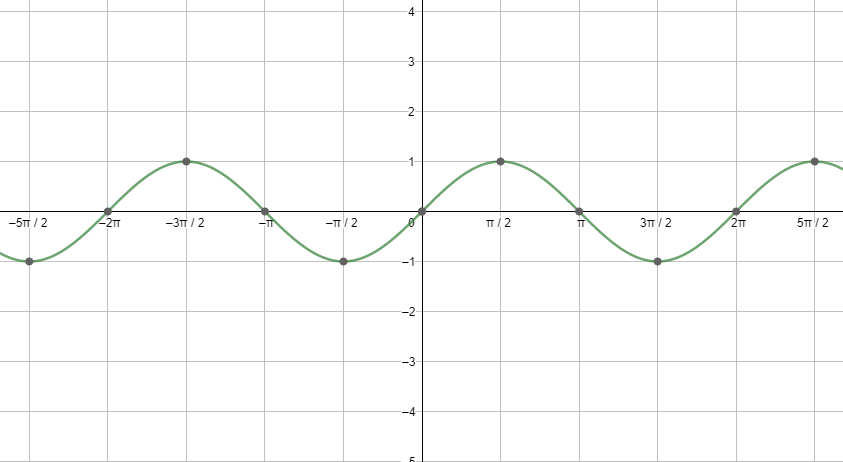
Answer
482.7k+ views
Hint: Try to simplify the left-hand side of the equation that we need to prove by using the property that $\cos \left( 90{}^\circ -\alpha \right)=\sin \alpha $ , $\cos \left( 90{}^\circ +\alpha \right)=-\sin \alpha $ , and other similar formulas. You will also need the formula $\cos A\cos B+\sin A\sin B=\cos \left( A-B \right)$ .
Complete step-by-step answer:
Before moving to the solution, let us discuss the periodicity of sine and cosine function, which we would be using in the solution. All the trigonometric ratios, including sine and cosine, are periodic functions. We can better understand this using the graph of sine and cosine.
First, let us start with the graph of sinx.

Next, let us see the graph of cosx.

Looking at both the graphs, we can say that the graphs are repeating after a fixed period i.e. $2{{\pi }^{c}}$ . So, we can say that the fundamental period of the cosine function and the sine function is $2{{\pi }^{c}}=360{}^\circ $
We will now solve the left-hand side of the equation given in the question.
$\cos \left( 36{}^\circ -A \right)\cos \left( 36{}^\circ +A \right)+\cos \left( 54{}^\circ +A \right)\cos \left( 54{}^\circ -A \right)$
Now we know $\sin \left( 90{}^\circ -x \right)=\cos x$ . On putting these values in our expression, we get
$\cos \left( 36{}^\circ -A \right)\cos \left( 36{}^\circ +A \right)+\sin \left( 90{}^\circ -\left( 54{}^\circ +A \right) \right)\sin \left( 90{}^\circ -\left( 54{}^\circ -A \right) \right)$
$=\cos \left( 36{}^\circ -A \right)\cos \left( 36{}^\circ +A \right)+\sin \left( 36{}^\circ -A \right)\sin \left( 36{}^\circ +A \right)$
Now we know $\cos A\cos B+\sin A\sin B=\cos \left( A-B \right)$ . Therefore, our expression becomes:
$\cos \left( 36{}^\circ +A-\left( 36{}^\circ -A \right) \right)$
$=\cos 2A$
As we have shown that left-hand side of the equation given in the question is equal to right-hand side of the equation in the question we can say that we have proved that $\cos \left( 36{}^\circ -A \right)\cos \left( 36{}^\circ +A \right)+\cos \left( 54{}^\circ +A \right)\cos \left( 54{}^\circ -A \right)=\cos 2A$ .
Note: Be careful about the sign in the formula of cos(A-B). Also, be careful about the signs while opening the brackets, as the general mistake that a student can make is 1+x-(x-1)=1+x-x-1. Also, you need to remember the properties related to complementary angles and trigonometric ratios. Whenever you come across a question where you see the trigonometric ratios of non-standard angles, always try to eliminate the non-standard angles using trigonometric identities, as we did in the above question.
Complete step-by-step answer:
Before moving to the solution, let us discuss the periodicity of sine and cosine function, which we would be using in the solution. All the trigonometric ratios, including sine and cosine, are periodic functions. We can better understand this using the graph of sine and cosine.
First, let us start with the graph of sinx.

Next, let us see the graph of cosx.

Looking at both the graphs, we can say that the graphs are repeating after a fixed period i.e. $2{{\pi }^{c}}$ . So, we can say that the fundamental period of the cosine function and the sine function is $2{{\pi }^{c}}=360{}^\circ $
We will now solve the left-hand side of the equation given in the question.
$\cos \left( 36{}^\circ -A \right)\cos \left( 36{}^\circ +A \right)+\cos \left( 54{}^\circ +A \right)\cos \left( 54{}^\circ -A \right)$
Now we know $\sin \left( 90{}^\circ -x \right)=\cos x$ . On putting these values in our expression, we get
$\cos \left( 36{}^\circ -A \right)\cos \left( 36{}^\circ +A \right)+\sin \left( 90{}^\circ -\left( 54{}^\circ +A \right) \right)\sin \left( 90{}^\circ -\left( 54{}^\circ -A \right) \right)$
$=\cos \left( 36{}^\circ -A \right)\cos \left( 36{}^\circ +A \right)+\sin \left( 36{}^\circ -A \right)\sin \left( 36{}^\circ +A \right)$
Now we know $\cos A\cos B+\sin A\sin B=\cos \left( A-B \right)$ . Therefore, our expression becomes:
$\cos \left( 36{}^\circ +A-\left( 36{}^\circ -A \right) \right)$
$=\cos 2A$
As we have shown that left-hand side of the equation given in the question is equal to right-hand side of the equation in the question we can say that we have proved that $\cos \left( 36{}^\circ -A \right)\cos \left( 36{}^\circ +A \right)+\cos \left( 54{}^\circ +A \right)\cos \left( 54{}^\circ -A \right)=\cos 2A$ .
Note: Be careful about the sign in the formula of cos(A-B). Also, be careful about the signs while opening the brackets, as the general mistake that a student can make is 1+x-(x-1)=1+x-x-1. Also, you need to remember the properties related to complementary angles and trigonometric ratios. Whenever you come across a question where you see the trigonometric ratios of non-standard angles, always try to eliminate the non-standard angles using trigonometric identities, as we did in the above question.
Recently Updated Pages
10 Examples of Evaporation in Daily Life with Explanations

10 Examples of Diffusion in Everyday Life

1 g of dry green algae absorb 47 times 10 3 moles of class 11 chemistry CBSE

If x be real then the maximum value of 5 + 4x 4x2 will class 10 maths JEE_Main

If the coordinates of the points A B and C be 443 23 class 10 maths JEE_Main

What happens when dilute hydrochloric acid is added class 10 chemistry JEE_Main

Trending doubts
Fill the blanks with the suitable prepositions 1 The class 9 english CBSE

Which are the Top 10 Largest Countries of the World?

How do you graph the function fx 4x class 9 maths CBSE

Who was the leader of the Bolshevik Party A Leon Trotsky class 9 social science CBSE

The Equation xxx + 2 is Satisfied when x is Equal to Class 10 Maths

Differentiate between homogeneous and heterogeneous class 12 chemistry CBSE

Difference between Prokaryotic cell and Eukaryotic class 11 biology CBSE

Which is the largest saltwater lake in India A Chilika class 8 social science CBSE

Ghatikas during the period of Satavahanas were aHospitals class 6 social science CBSE




